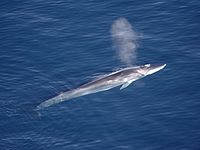
Photo from wikipedia
Fin whales are a cosmopolitan species found in the largest water masses of the world. In Malaysia, as well as other tropical countries in the Southeast Asian region, literature on… Click to show full abstract
Fin whales are a cosmopolitan species found in the largest water masses of the world. In Malaysia, as well as other tropical countries in the Southeast Asian region, literature on fin whales is limited, and as a result, there is confusion regarding their distribution range in the region. This study utilizes the fresh tissue of the skin and blubber of a dead fin whale that was stranded in Sabah (Borneo, Malaysia) on the coast of the South China Sea to confirm the species identity, possible properties of the species' diet, and any trace element contamination. The DNA profile results confirmed that the whale belonged to Balaenoptera physalus. Further investigation of its cytochrome b gene sequence indicated that it was closely related to the southern fin whale (Balaenoptera physalus quoyi). This finding indicates that fin whales indeed migrate to warm tropical waters and that their continuous global distribution spans the equatorial region. The dominant fatty acids, such as C18:0, C16:1, C18:1N9T and C16:0 profiles, were consistent with the pelagic plankton diet that the whale would have had during its migration in the tropical waters of the South China Sea. The whales are likely pelagic feeders and thus need to be offshore, which would explain why they are rarely seen in shallow coastal areas during migration in these waters. The concentrations of K, Ca, Sc, Mg and Al ranged from 0.45 μg g-1 to 7.80 μg g-1, while Cr, Cd, As and Pb were either very low or could not be detected. This is consistent with concentrations of trace elements previously reported for other baleen whale genera from the Southern Ocean. Our study demonstrates the importance of the South China Sea as a migration route for the southern fin whale, since it is a rich food source with relatively low contaminant levels. The South China Sea is therefore well-suited to ensure these whales' survival during migration.
Journal Title: Zoological studies
Year Published: 2022
Link to full text (if available)
Share on Social Media: Sign Up to like & get
recommendations!